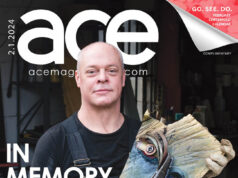BY ALAN SCULLEY
For much of 1996 and 1997, Green Day – the band that brought punk rock into the music mainstream – were conspicuously out of the public eye. It’s quite a switch from a two-year period between 1994 and 1996 when Green Day seemed to be everywhere you looked.
At the time Green Day’s third CD, the 1994 release Dookie, was racking up more than eight million in sales and the band’s 1995

But by the end of the Insomniac tour, The trio-singer/guitarist Billie Joe Armstrong, bassist Mike Dirnt and drummer Tre Cool-knew it was time to step off the rock and roll roller coaster and try to get life back to normal.
“We were tired,” Armstrong admits. “We decided to go home because it was just beginning to not be fun for us anymore. I think I can speak for the rest of the band when I say that.”
Normal life for Green Day, however, didn’t mean simply turning their hiatus from the public eye into an extended vacation. It meant getting back to what mattered most to the band-working as a creative unit.
“We just took it back to what we knew and what we were used to before, using the old garage, you know,” Cool said. “We just wrote all these songs (nearly 40 in all), you know, demo-ing them ourselves and kept practicing and practicing them and got them really tight. We played like every day for a year.”
For all the hype that surrounded Green Day as Dookie was changing the face of alternative radio, this woodshedding period may provide the truest picture of what makes Green Day tick. First and foremost, Armstrong says, their lives are about music
“I’ve always been taking my songwriting really seriously, regardless of what anybody really thinks,” Armstrong said.
The CD that emerged from the extended songwriting period may well be putting the focus on Green Day’s music once and for all. Called Nimrod, the 18-song CD brings out several dimensions that had rarely been heard within the Green Day sound.
To be sure, there are still plenty of catchy rapid fire punk rock songs (“Nice Guys,” “Platypus” and “Jinx” to name a few) that have always been Green Day’s signature. But the CD also includes a couple of tunes that would make any power pop band proud (the current hit single “Redundant” and “Worry Rock”); an acoustic ballad (the recent radio hit “Good Riddance”); a deliberate surf-rock-style instrumental (“Last Ride In”); and a tune (“Walking Alone”) that combines harmonica and pop much like the Beatles did on tunes like “Love Me Do.”
“I think on the last record [Insomniac] we were hesitant in showing [diversity],” Armstrong said. “On the last record we purposely wanted to do a record that sort of had more of a one-track mind and was kind of more ballsy and also in the process sort of give us room to grow after that. And this time we let it all hang out. I think we left ourselves a little bit vulnerable (to criticism), and I think it’s really important to be a little more vulnerable because honesty is always the best thing. You have to be completely honest 100 percent and you have to take a side no matter what when it comes to writing anything, like an art form or whatever. And that’s what we did. It was great. The record, we’re really happy with it.
“I just really wanted to get into songwriting, just kind of grow more and just put out the best record we can because at the end of the day it’s like that’s what really matters no matter which way you package it,” Armstrong added.
Making such a multi-dimensional record turned out to be anything but a simple task. Armstrong, in fact, calls it the most difficult project the band has ever tacked.
“I think it was the longest process we’ve ever taken,” Armstrong said. “We had a lot of songs. We ended up recording everything, well close to everything. I think when we got to 30, we decided it was a good idea to stop there. Otherwise we were going to be in the studio for the rest of our lives. So we took each song as its own individual character, and tried to make sure (it was right). We microscoped a lot and made sure we all were thoroughly happy with how everything came out.”
With Nimrod having restored Green Day to their place as a major presence on alternative rock radio – the CD has gone platinum and reached the top 10 on album charts-and the tumultuous events of the group’s whirlwind success of 1994-96 behind him, Armstrong sounds centered and enjoying life in a touring band.
He admits, though, that Green Day’s initial rise to fame and fortune was probably as dramatic as it seemed. Remember, this band came from decidedly modest circumstances.
Armstrong and Dirnt, friends since fifth grade, had both grown up in poor families. They met Cool and broke into music as part of the punk scene in Berkeley, California that was based around the now-famous club Gilman Street Project. Before their commercial breakthrough, the band had mainly only made waves within underground circles, releasing two independent CDs, 39/Smooth and Kerplunk, and touring small clubs around the country.
Still Armstrong said he took pains to make sure he didn’t lose touch with his beginnings or his beliefs as the band became household names.
“You know, it’s like I got married and I have a kid, so that’s definitely an adjustment within itself,” Armstrong noted. “Like here’s this lifestyle that’s completely selfless and self-absorbed at the same time. And money is just, you know I’ve never been a big spender anyway. Like I have a cool little house and I have the same car I’ve been driving for like the past six years, and I really don’t have a need to spend money. A lot of people kind of think ‘Don’t you just want to go out and blow a lot of money and buy like a Mazeratti?’ No. This is a lifestyle. Punk rock has been a part of me for the past 10 years of my life, even longer than that now. And I can’t just completely abandon the past 10 years of my life. It’s just something that’s set in stone. This is a lifestyle that I chose and it’s really kind of a religion too.”
This isn’t to say Armstrong is trying to live in the past. In fact one of the great lessons he’s learned to keep himself centered is to focus on the present.
“You know, I can’t look at the past. I’ve got to go forward,” he said. “I can’t keep trying to find something that I sort of lost a long time ago. I guess one of my problems is I sort of never really appreciate the present until it’s past…What I really had to learn how to do was sort of live in the now and not keep worrying about my past or worrying about, it’s like I have my friends who I’ve always had for years. And that is a scene within itself. It’s like the other night I had friends over in my back yard and we just sat around and like roasted marshmallows over a fire. And that is like the best times people can have. Having an illegal fire in your back yard is great. That’s a scene within itself. and it was really good for me. Living life like that is really good for me. Maybe it’s not going to be at Gilman Street anymore, but it’s always going to be somewhere. Let the other kids sort of take over that place now.”
Green Day plays May 20, 1998 at Bogart’s in Cincinnati.







